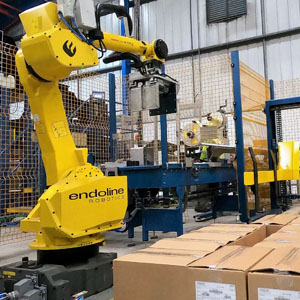Endoline Robotics transforms productivity for top supermarket cereal supplier
It is the largest and most innovative installation in Endoline Automation’s 42-year history. Valued at over £2.5 million, it is also the biggest order since Endoline Robotics launched at PPMA 2019. For Life Health Foods located in Peterborough, doubling production output has delivered transformational business benefits.
In May 2023, the Endoline Robotics team installed the fully operational start-to-pallet cell at Life Health Foods. Segregating clean food processing from warehouse palletising, the turnkey design addressed every production, safety, traceability and warehouse logistics productivity pain point.
This investment by Life Health Foods has delivered the capacity to process, palletise, wrap and rack 86,000 product cases every 24 hours. Enabling the cereal producer to seamlessly switch from manual palletising while simultaneously eliminating human labelling and palletising errors and boosting staff morale.
The installation comprises three Fanuc M410 palletising robots, over 250 metres of straight, spiral and overhead conveyor, integrated with a centralised ERP system. The greatest logistical challenge was relocating palletising from the clean production space to the adjacent warehouse located over 90 metres away.
All of this was done without increasing the physical footprint. What’s more, the switch from manual palletising to fully automating the handling of 100 different SKUs and product cases, was delivered without shutting production down.
Group HSE Manager at Life Health Foods (UK) Jon Edgley enthuses: “This fully automated palletising turnkey line has increased the versatility for our busy plant. We have already observed that staff morale is higher, labour costs are down, line speeds improved, and palletising errors eliminated. There are also significant workforce health & safety and stock control benefits.”
Ergonomic and efficient
Integrating products from five major OEMs, 86,000 cereal cases destined for Aldi, Asda, Booths, Coop, Dansk, Lidl, M&S, Morrisons, Musgroves, Sainsburys and Tesco, are now transported daily from production to palletising, with minimal human intervention.
Working within the existing warehouse footprint, Endoline Robotics designed the entire configuration, including the special 90- metre long, 3.5 metre high overhead conveyor. By running it along the perimeter of the existing warehouse, rather than down the middle, the cereal producer was able to maintain its existing loading docks and delivery access points. The elevated height ensures forklift operatives have full ground clearance, mitigating safety and collision risks.
From the 11 cereal packing lines, product cases are labelled by one of eight GSI1- compliant Markem-Image 2200 print and apply label systems. Using Endoline’s ERP software, all of the label and case information is fed into Life Health Foods SAP system, relaying in real time to the palletising sorting sensors exactly what’s in every box, the manufacturing time and pallet destination.
“This provides the SEDEX plant with additional reporting and data assurance as the print and apply case labelling machines are connected to the centralised ERP and SAP software systems, plus the robot palletisers,” highlights UK sales manager Suraj Patel.
Without interruption, 11 AmbaFlex spiral conveyors featuring Interroll rollers transport each labelled product case up onto the overhead conveyor. Sensors on the Intralox Switch conveyor assembles, sorts and ensures the correct case is delivered to the correct palletising cell. Cases that don’t have an assigned palletising line are segregated into a safe holding space.
The palletising operation is equally streamlined and compact. To maintain the small footprint and without losing any of the existing racking space, Endoline Robotics located the palletising cells in the warehouse corner. Here, five automatic Endoline pallet destackers feed empty pallets to the three Fanuc M-410-ic robots when the signal is issued.
Serving two pallet lines simultaneously, the Fanuc palletising robots stack up to seven cases a time onto the right product pallet in the correct palletising pattern. A paper top sheet is placed between each layer.
A caged shuttle moves the full pallets inside the cell for stretch wrapping. Operatives then collect and move the wrapped pallets onto the racking using forklifts.
To meet production and workforce safety standards, the complete palletising operation is contained within a guarded enclosure incorporating physical safety fencing, interlocked doors, and light curtains on all openings.
Automation advocates
The entire team has been hugely complimentary about the new installation. In particular it has helped with staff morale, especially the retained warehouse team.
Previously palletising manually, Jon comments “The entire process from production to palletising is noticeably more efficient and streamlined. Encouraging the input from staff was especially valued. From sharing viewpoints when Endoline Robotics was scoping out the design, to now having the responsibility of overseeing the day-to-day maintenance of the cells has given everyone in the team a real boost. We’ve all enjoyed learning new skills and understanding how all of the different automation and software elements come together.”
Site production manager Jon adds: “In terms of footprint, Endoline’s ability to accommodate our existing format in such an innovative way means that we are now fully utilising every inch of space in a smarter, more productive way. The ERP reporting system especially helps us to red flag any quality and stock issues and proactively address packing to palletising bottlenecks before they become an issue.”
This investment, affirms Jon, is integral to the plant’s long-term ambition of full upstream automation. “Having seen the immediate productivity benefits from the end-of-line palletising cells, we are now eager to pull forward on our upstream automation, case sealing and packing investments.”
End



